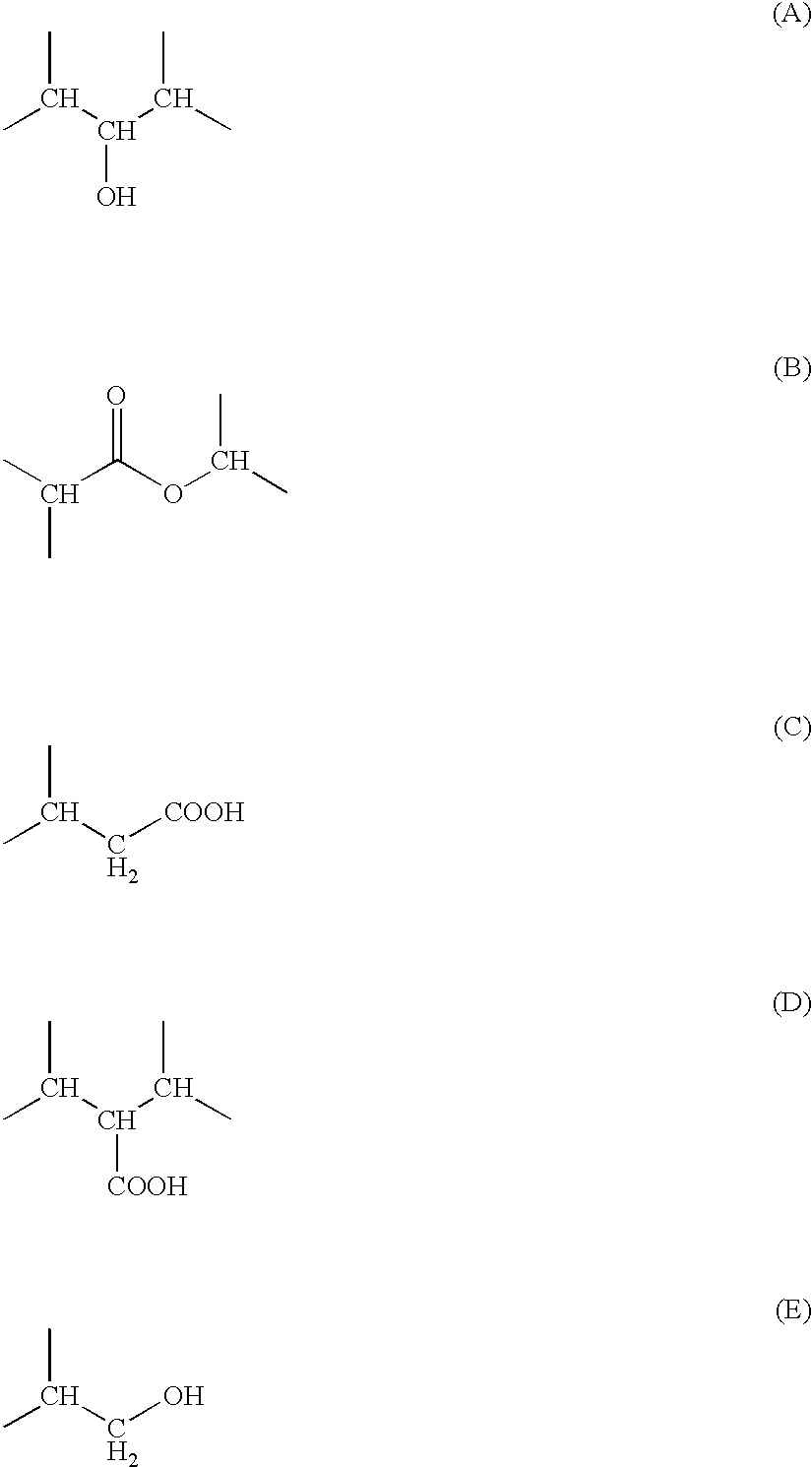Toner having hydrocarbon wax with specific ester value and hydroxyl value
a technology of hydrocarbon wax and hydrocarbon wax, which is applied in the field of toner, can solve the problems of affecting the performance of the image forming apparatus using the toner, and affecting the performance of the image forming apparatus
- Summary
- Abstract
- Description
- Claims
- Application Information
AI Technical Summary
Benefits of technology
Problems solved by technology
Method used
Image
Examples
polymer production example 1
300 parts of xylene was placed in a four-necked flask, and the interior of the flask was sufficiently aerated with nitrogen under stirring. Then, the xylene was heated and subjected to refluxing. Under the reflux condition, a liquid mixture of 69.0 parts of styrene, 22 parts of n-butyl acrylate, 9.0 parts of monobutyl maleate and 1.8 parts of di-tert-butyl peroxide was added dropwise in 4 hours and held for 2 hours for completing the polymerization, followed by removal of the solvent to obtain Polymer (L1) of a low-molecular weight. Polymer (L1) provided a GPC chromatogram showing a peak molecular weight (Mp) of 15200 and an acid value of 29.6 mgKOH / g. The polymerization composition, peak molecular weight (Mp) and acid value of Polymer (L1) are shown in Table 2 together with those of polymers obtained in the following Polymer Production Examples.
Polymer Production Examples 2-6
Polymers (L2)-(L5) and (H4) of low molecular weight were prepared in the same manner as in Polymer Productio...
polymer production example 7
Into a four-necked flask, 180 parts of deaerated water and 20 parts of 2 wt. %-polyvinyl alcohol aqueous solution were placed, and a liquid mixture of 70.9 parts of styrene, 25 parts of n-butyl acrylate, 4.1 parts of monobutyl maleate and 0.18 part of 2,2-bis(4,4-di-tert-butylperoxycyclohexyl) propane, was added thereto, followed by stirring to form a suspension liquid. After the interior of the flask was sufficiently aerated with nitrogen, the system was heated to 90.degree. C. to initiate the polymerization. The system was held at that temperature for 24 hours to complete the polymerization. The polymerizate was filtered out, washed with water and dried to obtain Polymer (H1) of high molecular weight. Polymer (H1) provided a GPC chromatogram showing Mp.=8.2.times.10.sup.5 and exhibited an acid value of 5.3 mgKOH / g.
Polymer Production Examples 8 and 9
Polymers (H2) and (H3) of high molecular weight were prepared in the same manner as in Polymer Production Example 7 except for changin...
example 1
The above ingredients were melt-kneaded by means of a twin-screw extruder heated at 130.degree. C. After cooling, the kneaded product was coarsely crushed by a hammer mill and then finely pulverized by a jet mill. The pulverizate was classified by a fixed wall-type pneumatic classifier to obtain classified powder, which was further subjected to strict classification by means of a multi-division classifier ("Elbow Jet", made by Nittetsu Kogyo K.K.) utilizing the Coanda effect for removal of fine powder fraction and coarse powder fraction to obtain a negatively chargeable magnetic toner having a weight-average particle size (D4) of 6.8 .mu.m.
The thus-prepared magnetic toner in 100 wt. parts was blended with 1.2 wt. parts of hydrophobic silica fine powder by means of a Henschel mixer to obtain a Developer 1. Physical properties of Developer 1 thus obtained are shown in Table 4 together with those of toners prepared in other Examples and Comparative Examples described hereinafter.
PUM
 Login to View More
Login to View More Abstract
Description
Claims
Application Information
 Login to View More
Login to View More - R&D
- Intellectual Property
- Life Sciences
- Materials
- Tech Scout
- Unparalleled Data Quality
- Higher Quality Content
- 60% Fewer Hallucinations
Browse by: Latest US Patents, China's latest patents, Technical Efficacy Thesaurus, Application Domain, Technology Topic, Popular Technical Reports.
© 2025 PatSnap. All rights reserved.Legal|Privacy policy|Modern Slavery Act Transparency Statement|Sitemap|About US| Contact US: help@patsnap.com



